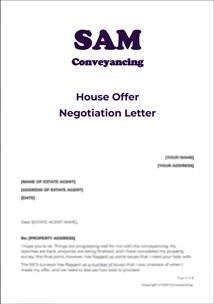Leasehold Survey for Flats & Houses
Purchasing a leasehold property, whether it's a flat, maisonette, or even a house, comes with its own considerations beyond a freehold. While a flat survey isn't always a legal requirement (unless mandated by your lender), opting for a specialist leasehold survey is highly recommended.
Unlike looking at the property in isolation, a RICS survey provides an assessment of not just the individual property but also highlights potential issues within the wider building structure, which could lead to future service charges or major works contributions.
Why do you need a Leasehold Survey?
Unlike a freehold, where you own both the building and the land it sits on, buying a leasehold means you own the property for a fixed period, and the land (and often the building's structure) is owned by a freeholder.
More than just a flat: the building as a whole
One of the primary reasons a survey for a leasehold flat or house is so crucial is that it assesses not just the individual property you are buying, but also the wider building structure.
As a leaseholder, you will be required to contribute towards the upkeep, maintenance, and major works of the entire building through service charges and ground rent. A standard visual inspection of just your flat will not give you sufficient information on these future costs.
A specialist RICS surveyor will look for issues in common areas, the roof, external walls, foundations, and other structural elements that could lead to substantial service charge demands or major works contributions in the future.
The unique leasehold risks
- Without a survey, you could inherit a share of expensive repairs to the building's roof (e.g., widespread leaks, ageing tiles), exterior (e.g., crumbling facade, unsafe balconies), or communal areas (e.g., outdated heating systems, failing lifts) that were not apparent during viewings.
- A survey can highlight issues that indicate future increases in service charges for maintenance or necessary repairs, such as deteriorating communal pipework, an ageing fire alarm system, or a building in need of significant redecoration.
- Problems like cracks indicating subsidence, widespread penetrating damp from external walls, or rotting roof timbers can impact the value and safety of the flat, even if the issue isn't directly within the unit.
- While the survey doesn't directly value a lease extension, it provides an assessment of the property's physical condition. A property with defects or maintenance issues will have a lower market value, which can indirectly impact the premium you might pay for a future lease extension.
A seller is prohibited from lying about the property; the responsibility to investigate and ask the right questions lies with the buyer. If an expensive defect is missed because you skip the leasehold survey, you could end up with a property worth much less than you paid for it, or face unexpected and significant repair bills.
In our recent survey, 16% of homeowners found defects; including 2% who were able to pull out of a bad purchase, 7% who were able to negotiate a better price, and sadly, 7% of homeowners who did not get a survey and discovered defects after the purchase.
12 of the 39 who remembered how much these defects cost to remedy spent over £5,000
Don't burn your money, book a survey.

Types of Leasehold Surveys
Once you understand the importance of getting a leasehold survey, the next step is to choose the right type of survey for your property. The Royal Institution of Chartered Surveyors (RICS) offers levels of surveys, each designed for varying property types and conditions.
Selecting the most appropriate survey for a leasehold flat or house is key to getting the insights you need.
RICS Level 3 Home Survey (Building Survey)
The RICS Level 3 Home Survey, previously known as a Building Survey, is the most comprehensive survey available. It is recommended for older, larger, or more complex leasehold properties, or if you have concerns about the property's condition.
It provides a more extensive and detailed inspection, offering in-depth analysis of the property's structure and fabric.
- Period properties (anything built before 1950), especially those with unusual construction.
- Properties that are dilapidated or appear to be in poor condition.
- Properties that have undergone significant alterations or extensions.
- If you plan major renovation or structural work on the property.
A Level 3 survey allows the surveyor considerably more time for a thorough inspection, including a detailed examination of roofs, floors, and services (through non-intrusive methods).
It will aim to establish the building materials and techniques, how they are likely to perform in the future, and recommend necessary repairs and the risks of not acting.
New Build Leasehold Properties: Snagging Survey
Do new build leasehold properties need a survey? For a brand new flat purchase or house, a full RICS Level 2 or Level 3 survey is generally not necessary.
This is because new builds are legally required to adhere to strict building regulations and typically come with a warranty (e.g., NHBC) covering major structural defects for 10 years.
However, a snagging survey is highly recommended for new build leasehold properties. This survey focuses on identifying minor defects, cosmetic issues, and unfinished work left by the builders. Common snags include:
- Damaged materials (e.g., chipped tiles, scratched windows).
- Substandard finishes (e.g., poor paintwork, uneven plaster).
- Faulty installations (e.g., leaky plumbing, ill-fitting doors/windows).
- Electrical or heating issues.
A snagging survey aims to catch any sloppy or unfinished work before you move in, allowing you to present a list to the developer for rectification under their warranty obligations.
Even leaseholds of just a few years old should consider a Level 2 survey to protect you as the buyer, as minor issues can quickly escalate.
Lease Extension Valuation
This is NOT suitable when purchasing a leasehold property, but it is for lease extensions.
If your lease has fallen below the 80-year mark, or it's about to, you should commission a lease extension valuation as soon as possible.
Cost of a Leasehold Survey
SAM Conveyancing's cost for a leasehold survey starts from £375 EXC VAT. It's important to note that prices can vary based on the property's size, location, and the type of survey chosen.
Typical Leasehold Survey costs
As a general guide, the cost for a leasehold survey typically falls within these ranges:
- RICS Level 2 Home Survey: For a standard leasehold flat or house, a Level 2 survey might cost between £400 - £800. This is the most common option for properties in reasonable condition.
- RICS Level 3 Home Survey: For larger, older, or more complex leasehold properties, a Level 3 survey is more extensive and therefore more expensive, typically ranging from £800 - £1,500+.
- Snagging Survey (New Builds): For brand new leasehold properties, a snagging survey is usually the most cost-effective option, often ranging from £300 - £600, depending on the size of the property.
These are approximate figures, and the actual flat survey cost will be confirmed by your RICS surveyor based on a detailed quote for your specific property.
What influences the cost?
- Property Size: Larger flats or houses will generally incur higher survey fees due to the increased time required for inspection.
- Property Type and Age: Older properties, particularly those in period buildings, and more complex structures (e.g., a flat in a converted historic building vs. a modern purpose-built block) typically require a more in-depth survey (Level 3) and thus cost more.
- Location: Survey costs can vary slightly depending on the region of England & Wales, reflecting local market rates and surveyor availability.
- Surveyor's Experience: Highly experienced or specialist surveyors might charge a premium for their expertise.
- Urgency: While not always possible, requesting a very fast turnaround might sometimes affect the fee.
While a survey is an upfront expense, consider it an essential investment. Identifying significant issues before committing to a purchase can save you tens of thousands of pounds in unexpected repair bills or allow you to renegotiate the purchase price, making the cost of a leasehold survey a worthwhile expenditure.
Call or send us a message to request a callback or an email answering your queries about our surveys.
Our UK-based survey team can help you choose the right level of home survey for your property, at no extra charge.
There's no obligation to instruct. We'll make sure you understand your options and provide a free, fixed-fee quote for our best-value survey to meet your needs.
No robots, no call centres. Property challenges solved.
Using your survey for negotiation
One of the most valuable benefits of commissioning a leasehold survey is the negotiation power it can provide, both for the property purchase price and a lease extension premium. If your survey for a flat purchase uncovers defects, unexpected repair requirements, or potential future service charge burdens within the building, these findings can form a strong basis for renegotiation with the seller.
How survey findings aid negotiation:
- Evidence-Based Argument: A professional RICS survey provides objective, expert evidence of issues that might reduce the property's value or incur future costs. This moves the negotiation beyond subjective opinions.
- Cost Quantification: The survey can highlight or estimate the costs of necessary repairs or major works, giving you concrete figures to present to the seller.
- Reduced Risk for You: By identifying problems upfront, the survey allows you to factor these into your offer, reducing your financial risk after purchase.
If your RICS surveyor deems the property to be worth less than your offer due to issues uncovered in the leasehold survey, they can work with your solicitor to help you negotiate the price with the seller.
This could lead to a reduction in the asking price, a contribution towards repair costs, or an agreement for the seller to carry out the repairs before completion.
Download a house price negotiation letter template, free from hassle.
- Instant download.
- Easy to fill in.
- Suitable for negotiating offers after the survey.
- Templates for initial and final offers.
The templates will be attached to your confirmation email after payment. Please allow a couple of minutes for the email to arrive.

Caragh is an excellent writer and copy editor of books, news articles and editorials. She has written extensively for SAM for a variety of conveyancing, survey, property law and mortgage-related articles.
Andrew started his career in 2000 working within conveyancing solicitor firms and grew hands-on knowledge of a wide variety of conveyancing challenges and solutions. After helping in excess of 50,000 clients in his career, he uses all this experience within his article writing for SAM, mainstream media and his self published book How to Buy a House Without Killing Anyone.










